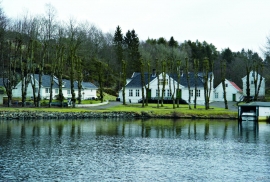Published: 28.01.2013 | Author: Per Jahn Lavik
Prospect of Alvøen painted by Johan Christopher Johnsen, 1808 (Egil Korsnes, owner: Stiftelsen Alvøen Hovedbygning).
In the 1740s the brothers Hendrik and Didrik Fasmer bought the gunpowder mill at Alvøen, and the family has been closely linked to the place ever since. This was a family of rich Bergen residents who had immigrated from Bremen in the 16th century. The works at Alvøen was one of the trading and industrial enterprises the family was engaged in, and throughout the 1700s the property expanded through new acquisitions. An extensive sheep-farming business provided manure that was used in the gunpowder production. The gunpowder factory from the beginning of the 1600s – one of Norway’s oldest industrial enterprises, came to a complete halt in the 1880s. Other products then took over the market.
Paper production started in 1797, in the beginning by the hand-production of textile-based paper (klutepapir). One of the oldest buildings still standing is the old “Hengeriet” where the paper was hung up to dry in the loft. In the 1850s the first paper machines were acquired, and the textile mass was mixed with cellulose. It is textile paper of high quality that has been the most important product from Alvøen throughout the 20th century. For many years bank-note paper for Norges Bank was one of the main products. When the factory was closed down in 1981 a long industrial history came to an end.
A distinct feature in the landscape is the row of white workers’ houses that make out the core of the building mass. The Fasmer family built and owned these houses, which may be said to be the physical expression of a “paternalistic” welfare society; the industrial magnate ensured the welfare of his workers through providing good housing.
The foundation Alvøen hovedbygning
The old residence of the Fasmer family, with its beautiful park, is today owned by “The Foundation Alvøen Hovedbygning”, which has status as a museum under the management of Vestlandske Kunstindustrimuseum. The house contains a rich collection of equipment and objects that link the memories to the Fasmer family’s long traditions. Beautiful furniture, china, silver, paintings and textiles show how closely linked the Bergen merchant families were with foreign countries – Germany, the Netherlands and England, even as far away as China. The museum is open to the public May- September.
- Andersen, A. (1962) Alvøen med Loddefjord sogn. [Alvøy], A. Andersen.
- Fossen, K. (1984-1991) Laksevåg: strandstedet, jordbruks- og fiskerlandet ved søndre led. [Bergen], Bergen kommune.
- Gierløff, C. (1944) Alvøen og Fasmerslekten: 1744-25. juni-1944. Bergen.
- Goksøyr, M. (1983) Arbeidere i det før-industrielle brukssamfunn: Alvøens fabrikker 1800-1863. I: Skrifter (Bergens historiske forening). Bergen, Bergens historiske forening, nr. 80/81, s. 102-130.
- Jakobsen, E. (1970) Gards- og ættebok for Loddefjord sokn. Bergen.




